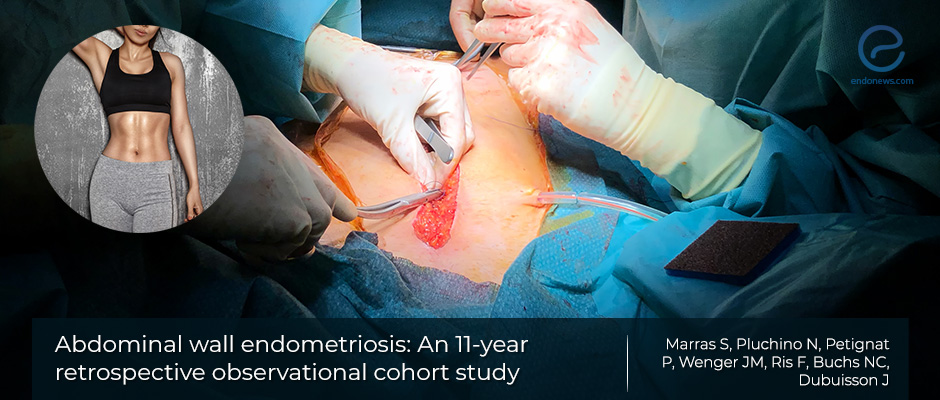Abdominal wall endometriosis: Who is at risk and what causes it?
Mar 31, 2020
What do we know about abdominal wall endometriosis?
Key Points
Importance:
- Abdominal wall endometriosis is a relatively uncommon presentation of endometriosis that requires further exploration.
Highlights:
- This manuscript reviews what is known about abdominal wall endometriosis.
- It notes the differential characteristics in Abdominal wall endometriosis patients with and without pelvic involvement that may be important in future clinical decision making.
What’s done here:
- This study assesses the clinical and descriptive characteristics in patients who presented with abdominal wall endometriosis.
Key Results:
- Thirty-five patients had confirmed endometriosis nodules on the abdominal wall. The mean age at presentation was 36, the standard deviation of about 6 years.
- Six women (17.1%) had no history of prior surgery and all these women presented with umbilical nodules, nulliparity, and presented with mild to severe endometriosis.
- The remaining 29 women (82.8%) had a history of gynecologic or obstetrical surgery, most commonly a cesarean section.
- 34% of women who were found to have abdominal wall endometriosis also had concurrent pelvic endometriosis.
- Women with concurrent pelvic endometriosis were more likely to have an umbilical nodule and were significantly less fertile, which may mirror two previously described pathogenic pathways for abdominal wall endometriosis: One develops via lymphatic or hematogenous, and other iatrogenic, such as cesarean section.
- The overall recurrence rate was 11.4% with a mean follow-up period of 5.2 years, with a mean time until recurrence of 3.4 years.
Limitations:
- Cesarean section indication and prior OB/GYN history was not obtained for the patients included in the study.
Lay Summary
Endometriosis is a condition that can cause anatomic, hormonal, and inflammatory disturbances that may ultimately result in decreased fertility or infertility. It is a disease process that is defined as ectopic endometrial-like tissue implanting itself to various pelvic and extra pelvic organs. One area that can be involved, is the inner surface of the abdominal wall, known as abdominal wall endometriosis. This rather uncommon presentation of endometriosis has a reported incidence of 0.03 to 3.5%, with most cases associated with a previous history of cesarean section. The nodules that characterize abdominal wall endometriosis are often mistaken for granulomas, cysts, lipomas, or hernias and thus contribute to their delayed diagnosis.
This manuscript was written by physicians from the Department of Obstetrics and Gynecology in Geneva published recently in the "European Journal of Obstetrics and Gynecology and Reproductive Biology" aims to review all cases of abdominal wall endometriosis with confirmed histopathology, and retrospectively managed over an 11-year period. Using the information obtained, the aim was to assess demographic, clinical characteristics, and recurrence rates after surgical intervention. Lesions were categorized based on their surgical intra-abdominal status according to the revised classification system of the American Fertility Society and as either isolated or pelvic endometriosis-associated abdominal wall endometriosis, depending on what lesions were visualized during laparotomy.
Thirty-five patients had confirmed endometriosis nodules on the abdominal wall that were surgically excised between the studied time period. The mean age at presentation was 36 years. Six women (17.1%) had no history of prior surgery and all these women presented with umbilical nodules, nulliparity, and mild to severe endometriosis. The remaining 29 women (82.8%) had a history of gynecologic or obstetrical surgery, most commonly a cesarean section, all had nodules located in the incisional scar. The incidence of abdominal wall endometriosis after the cesarean section was 0.23%. Three women underwent primary mesh repair. The overall recurrence rate was 11.4% with a mean follow-up period of 5.2 years, and a mean time until recurrence, 3.4 years.
The most common symptom was cyclic abdominal pain and cyclic bleeding. The mean interval between prior surgery and the presentation of abdominal wall endometriosis-related symptoms was 5.28 years. Most nodules (71.4%) were found in the suprapubic area during surgery, with 64% of those invading the fascial and/or rectus abdominis muscle. Additionally, 34% of women who were found to have AWE also had concurrent pelvic endometriosis.
Many preventive methods have been proposed to avoid abdominal wall endometriosis. Most of these recommendations concern the cesarean section itself. For example, some recommend that the visceral and parietal peritoneum should be sutured, instruments used should be changed for closure, and abundant abdominal lavage should be performed. While this study does offer a large number of patients, more studies are required to draw definitive answers on key clinical questions regarding the prevention of abdominal wall endometriosis and its surgical management.
Research Source: https://www.ncbi.nlm.nih.gov/pubmed/31650130
endometriosis abdominal wall surgery

